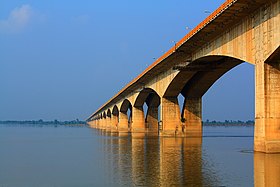Mahatma Gandhi Setu
Mahatma Gandhi Setu (also called Gandhi Setu or Ganga Setu) is a bridge over the river Ganges connecting Patna in the south to Hajipur in the north of Bihar. Its length is 5,750 metres (18,860 ft) and it is the second longest river bridge in India. It was inaugurated in May 1982 by the then Prime Minister, Mrs Indira Gandhi, inauguration took place at north end of the bridge located in Hajipur viewed by thousands of people.
| Mahatma Gandhi Setu | |
|---|---|

Aerial view of Mahatma Gandhi Setu
| |
| Coordinates | 25°37′19.0″N 85°12′25.7′19.0″N 85°12′25.7″E |
| Carries | National Highway 22 and National Highway 31 |
| Crosses | Ganga |
| Locale | Patna - Hajipur |
| Official name | Mahatma Gandhi Setu |
| Other name(s) | Ganga Setu |
| Named for | Mahatma Gandhi |
| Maintained by | National Highways Authority of India |
| Characteristics | |
| Design | Girder bridge |
| Material | Concrete and steel |
| Total length | 5.75 km (3.57 mi) |
| Width | 25 m (82 ft) |
| No. of spans | 45 |
| History | |
| Designer | Gammon India |
| Constructed by | Gammon India Limited |
| Construction start | 1972 |
| Construction end | 1982 |
| Opened | May 1982 |
| Statistics | |
| Toll | No (revoked) |
Planning and Significance
The bridge was approved by the Central Government in 1969 and built by Gammon India Limited over a period of ten years, from 1972 to 1982 with total expenditure of Rs 87.22 crore at that time. It was built to connect North Bihar with the rest of Bihar and part of national highway 19 (NH19). Before this bridge was constructed, Rajendra Setu, opened in 1959, was the only link to North Bihar. Since then, the Vikramshila Setu has also been built across the Ganges. Two more rail-cum-road bridges are currently under construction, between Digha and Sonepur and at Munger.
The Indian postal department issued a commemorative postage stamp on Landmark Bridges Of India: Mahatma Gandhi Setu of denomination 0500 Paise on 17 August 2007.
Engineering Details
The bridge consists 45 intermediate spans of 121.065 metres (397.19 ft) each and a span of 65.530 metres (214.99 ft) at each end.The deck provides for a 7.5 metres (25 ft) wide two-lane roadway for IRC class 70 R loading with footpaths on either side. The cantilever segmental construction method was adopted to construct this mega bridge. Each span has two cantilever beams on both sides which are free to move at the ends. It has two lanes one upstream and the other downstream each with a width of around 6m. Both the lanes are also free from each other and are not connected anywhere. It was constructed by using 3-meter pre-casted parts being joined at both ends to complete the span. The Spans are connected by using a Protrusion which is free to move longitudinally also along the river flow. In upwards and downwards direction it is such that it allows vibration to transfer smoothly to the next span while vehicular movement without much discreteness. The building of the bridge cost over $180,000
Structural integrity and failure
It is not designed for so much loading. It started major repairs within 5 years of its completion Providing central hinge bearing, poor maintenance, coupled with wear and tear caused by the unprecedented surge in traffic, made the structure vulnerable. Other bridges across the country built with the same design in cantilever technology but with slight variations have also developed cracks.
Investigations into the fissures developed in the segmental box revealed hammering at the hinges when vehicles plied; finger-type expansion joints in an advanced state of distress; wearing coat cracks; spilling of concrete at transverse joints; longitudinal cracks in precast segments; leakage of water inside the box girder from joints between segments and from holes provided for lifting the segments.
Gandhi Setu is now being dismantled. It may have happened that due to such inferior quality of reinforcement coupled with inferior concrete have been causes for such catastrophic failure. Stressed cables are not grouted at all. They are acting like de-bonded tendons. There is minimal stress left. That is why external pre-stressing made later could not make up the stresses losss. Even cables do not conform to the As-Built drawings submitted. All As-Built drawings say how improper the design was. Providing central hinge bearing may not have given so much of adverse effect as the problems cited above. Now it is becoming clear that there were faults in all the departments, be it design or construction or supervision or material deficiency. Needless to say, these are the reasons behind the dilapidated conditions of the bridge now.

